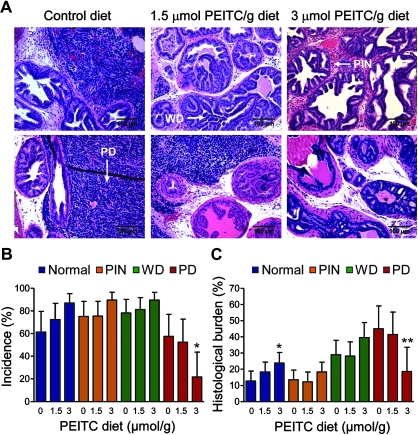Figure 3.
Effect of dietary phenethyl isothiocyanate (PEITC) administration on incidence and burden (affected area) of prostatic intraepithelial neoplasia (PIN), well differentiated carcinoma (WD), and poorly differentiated cancer (PD) in the dorsolateral prostate of mice transgenic for adenocarcinoma. A) Representative sections stained with hematoxylin and eosin of the dorsolateral prostate from control and PEITC-treated mice (×200 magnification). Areas consistent with PIN, WD, and PD are shown (arrows). Scale bar = 100 μm. B) Incidence (percent mice with histological evidence) of normal prostate (normal), low- and high-grade PIN, WD, and PD in the dorsolateral prostate of mice fed the control diet or the PEITC-supplemented diet (n = 19 for control diet [0 μmol PEITC/g diet] and 1.5 μmol PEITC/g diet groups, and n =18 for the 3 μmol PEITC/g diet group). *Statistically significantly different (P = .04) compared with control diet group by mixed-effects analysis of variance (ANOVA) with Dunnett adjustment. C) Percent area (affected area) of prostate gland occupied by the normal prostate (normal), PIN, WD, or PD carcinoma (n =19 for the control diet and 1.5 μmol PEITC/g diet groups, and n = 18 for the 3 μmol PEITC/g diet group). Ten random, non-overlapping, and non-necrotic fields from each section were scored by two independent investigators. *Statistically significantly different (P = .03) compared with control by mixed-effects ANOVA with Dunnett adjustment. **Statistically significantly different (P = .02) compared with control by mixed-effects ANOVA with Dunnett adjustment. All statistical tests were two-sided.

